CLL 合作语言学习法
社团学习法-社团语言学习教学法Teaching-Methodoly-Community-Language-Learning-(CLL)上课讲义

Theoretical basis: a theoretical assumption that language as social process is different from language as communication. “Communication is more than just a message being transmitted from a speaker to a listener. The speaker at the same time is both subject and object of his own message.” (La Forge 1983).
Helping students how to learn from one another.
Characteristics in different stages
Dependent: The learner repeats utterances made by the teacher in
the target language and overhears the interchanges between other learners and knowers.
Definition
Community Language Learning represents the use of counseling-learning theory to teach languages.
Community Language Learning draws on the counseling metaphor to redefine the roles of the teacher (the counselor) and learners (the clients) in the language classroom.
Cooperative Language Learning合作学习语言法(课堂PPT)

Traditional models of classroom learning are teacher-fronted, foster competition rather than cooperation, and favor majority students.
CLL has been embraced as a way of promoting communicative interaction in the classroom and is seen as an extension of the principles of Communicative Language Teaching. It is learner-centered.
7
CLL seeks to develop classrooms that foster cooperation rather than competition in learning. Within cooperative situations, individuals seek outcomes beneficial to themselves and all other group members. It is contrasted with competitive learning in which students work against each other to achieve an academic goal such as a grade of “A”.
Cooperhang Kun
1
Background
Cooperative Language Learning(CLL) is part of a more general instructional approach also known as Collaborative Learning(CL).
cll教学法

cll教学法CLL是一种基于交际语言教学理念的渐进性语言教学方法。
CLL教学法旨在培养学生的语言自信和语言能力,通过自主学习和自我评估来提高语言技能。
该方法注重语言的实际运用,并注重学生的学习兴趣和积极性。
下面将介绍CLL教学法的主要特点和教学步骤。
一、基本原则1、以学生为中心CLL教学法注重学生的参与和互动,认为学生是学习的主体。
教师的角色是指导者和帮助者,鼓励学生参与课堂活动,提高学生的自学能力。
2、语言运用为中心CLL教学法注重语言的实际运用,强调学生在实际交际中使用语言的能力。
教师要让学生在真实的语境中运用语言,培养学生的听、说、读、写的综合能力。
3、渐进性原则CLL教学法采用渐进性教学方法,通过逐步引导学生掌握语言知识,逐步提高语言能力。
教师要注重学生的个体差异,根据不同的学生能力和需求进行教学。
4、自主学习CLL教学法注重培养学生的自主学习能力,让学生在教师指导下主动探究和发现语言知识,通过反思和评价提高语言运用能力。
5、合作学习CLL教学法强调合作学习,通过小组合作和互动来加强学生的语言交流能力,同时也能增强学生的学习兴趣和积极性。
二、教学步骤1、导入在课堂开始之前,教师要通过图片、视频、音频等多种方式引起学生的兴趣和关注。
教师可以进行短暂的问答,使学生快速进入学习状态。
2、预习任务教师在课堂之前发给学生课文或活动的相关材料,让学生提前预习。
预习任务可以是填空、选择题、判断题等形式,让学生先了解内容。
3、课文展示教师在课堂上展示课文或活动内容,通过图片、视频、故事等多种方式呈现,让学生对语言内容有更深入的了解。
4、交流互动教师通过提问、小组合作等方式激发学生的学习兴趣,让学生在互动中掌握语言知识和技能。
教师可以根据学生的语言程度不同,对学生进行分组。
5、复述学生可以通过口语、写作等形式进行复述,巩固所学内容,并帮助教师了解学生的掌握情况。
6、评价教师可以通过随堂测试、作业、课堂表现等方式对学生进行评价,让学生了解自己的学习情况,促进自我反思和提高自主学习能力。
(完整版)论CLIL六步教学法

论CLIL六步教学法欧洲联盟(European Union),简称欧盟(EU),是由欧洲共同体(European Community)发展而来的。
目前,欧盟有27个成员国,随着欧洲一体化进程的加快,各成员国之间在政治、经济、文化等方面的交流也不断地增多。
在二十世纪九十年代中期,整个欧洲掀起了一股“在广泛的学习和教学的情境下整合语言和课目内容”的外语学习模式——CLIL,即“Content and Language Integrated Learning”首字母的缩写。
①一、CLIL的缘起和概念(一)缘起1、现实的需求②随着欧盟联合政治体系的建立,一个统一的欧洲需要通过在经济、文化以及跨越国界的流动性活动的过程中来实现。
目前,欧洲有27个成员国,有着极其丰富多样的语言背景。
所以,欧盟要想实现真正的大一统,“语言交际”在其成功的过程中发挥着重要的作用。
但是,目前虽说英语是使用的比较多的官方语言,可一些个别国家不希望自己国家的语言在欧盟内被降低为第二的地位;并且有一些国家强烈建议在自己的国家使用母语。
所以,随着语言交流的增多,对第二或者第三语言的交流技巧的需求也与日俱增。
2、政策的推动(1)马斯特里赫条的倡导③马斯特里赫条是欧盟成员国曾一致通过了保持欧洲语言和文化多样性的决议。
决议坚持认为想要实现欧洲大联盟这一伟大构想,首先必须保持这种多样性。
虽然这种通过维持多样性来实现统一的做法似乎过于理想化,但迫切的政治和经济需求却促使了双语制/多语制在欧盟的诞生,欧盟成员国之间的贸易往来逐年①Coyle D. ‘CLIL----a pedagogical approach from the European perspective’ in N.Van Deusen-Scholl andN.H.Hornberger(eds),Encyclopedia of Language and Education,2nd Edition,V olume 4:Second and Foreign Language,97-111.©2008 Springer Science+Business Media LLC.①Steve Darn.Content and Language Integrated Learning(CLIL) A European Overview [J] Online Paper.2006②Steve Darn.Content and Language Integrated Learning(CLIL) A European Overview [J] Online Paper.2006看涨,欧盟各国居民之间的交流也日渐频繁。
社团语言学习法的回顾与展望

社团语言学习法的回顾与展望【摘要】近些年来,英语语言在实际生活中的应用愈来愈普遍,因此英语教学的方法也成为了热议的话题。
其中以语言教学法和学习法的使用较为普遍,教学法与教学的成败息息相关,因此,教学法的选择就显得尤其重要。
出于教学法对学生学习的重要性,本篇文章主要讨论一种更具人性化的方法——社团语言学习法。
作为一种卓有成效的英语教学法,它更加关注教师与学生之间的沟通,通过教师倾听,学生提问的方法来促进教学过程,从而可以有效避免传统语言学习的机械性。
迄今为止,诸多研究者对社团语言学习法在英语教学中的作用进行了探究,也取得了相对可观的研究成果。
本篇文章主要回顾社团语言学习法的相关背景和理论基础等,与此同时也阐述了社团语言学习法在初中英语课堂上的实际运用以及优缺点。
关键词:社团语言学习法;初中英语引言社团语言学习法(Community Language Learning,简称CLL)是由美国心理学家和咨询领域专家Charles A.Curran提出的语言学习法,他利用心理学的咨询方法,把教师和学生看作顾问和客户。
与传统学习法相比,社团语言学习法更关注学生的情感与态度,在整个教学过程中,学生不仅能够掌握知识点,也能够陶冶情感。
本文将对社团语言学习法的基本理念和背景进行阐述,并分析其在初中英语教学中的运用。
1.社团语言学习法概述1.1定义社团语言学习法(Community Language Learning)在国内外教育界颇受欢迎。
19世纪70年代,美国芝加哥Loyola大学的教授Charles A.Curran[1]和他的助手提出了社团语言学习法,Curran不仅是一名心理学家,而且在咨询领域也是一名专家,他把教师和学生的关系定义成the counselor和the clients,即教师是顾问,学生是客户,在教学过程中,教师给学生提供帮助。
基于此原因,社团语言学习法的别名为“咨询学习法”(counseling-learning)。
社团语言学习法

社团语言学习法(Community Language Learning)社团语言学习法又称咨询法(Counseling Learning),产生于60年代初期的美国,是由古兰(Charles Curran)创立的。
这种教学法主要的教学目标是外语口语。
它的突出特点是以学生为中心,教服从学。
教师是顾问,是辅助者,学生是“病人”。
教师注意的中心是“病人”的需要。
另一个突出特点是依靠学生的母语,逐渐由学生的母语过渡到外语。
这种教学法的学习方式和过程是这样的:首先学生用母语建立相互信任的人际关系。
学生坐成一个圆圈,教师在圈外。
学生可以是零起点的外语学生。
如果一个学生想对小组或某个学生说几句话,他就用母语说,顾问就把他的话翻译成外语,然后让学生重复这句外语。
接着,别的学生就用母语回答,顾问再翻译,学生重复。
这样,会话就会继续下去。
如有可能,可以把会话录下来,引导学生归纳出一些有关新语言的信息。
如果学生愿意,顾问可以给更多的指导,解释一些语言规则。
在开始阶段,“病人”中会出现迷惑不解、混淆的情况,但是在顾问的帮助下,会慢慢好起来,开始用外语说一个词、一个短语,不用翻译。
这是“病人”由完全依赖顾问到独立学习的第一个标志。
随着“病人”对外语的逐渐熟悉,直接用外语交际就会发生,顾问的指导就会减少。
数月之后,“病人”就会用外语进行流利的交际。
从完全依赖顾问到完全独立,其间分以下五个阶段:1.完全依赖顾问;2.会说一些外语词和短语;3.逐渐独立,但还有一些错误需要顾问纠正;4.只需要顾问解释一些成语、具有特殊意义的固定表达法和语法;5.独立、自由地交际。
顾问虽出场,但保持沉默。
社团语言学习法的理论基础是人本主义心理学和以学生为中心的教育学。
社团语言学习法旨在创造和谐教学气氛,发挥教师在学生情感因素中所起的主导作用,以降低学生学习的情感障碍,提高外语教学效果。
辅以一些必要的修改,社团语言学习法同样适用于成人教育。
社团语言学习法(Community Language Learning)社团语言学习法又称咨询法(Counseling Learning),产生于60年代初期的美国,是由古兰(Charles Curran)创立的。
大学英语教学改革背景下社团语言学习法(CLL)教学策略探究
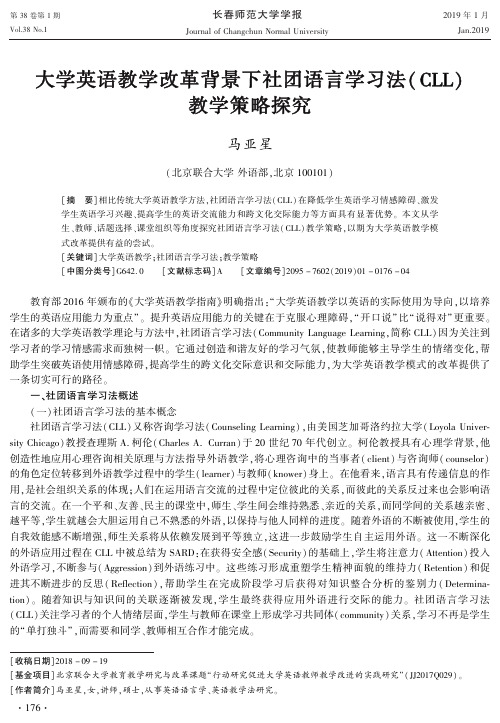
第38卷第1期Vol.38No.1长春师范大学学报Journal of Changchun Normal University2019年1月Jan.2019大学英语教学改革背景下社团语言学习法(CLL)教学策略探究马亚星(北京联合大学外语部ꎬ北京100101)[摘㊀要]相比传统大学英语教学方法ꎬ社团语言学习法(CLL)在降低学生英语学习情感障碍㊁激发学生英语学习兴趣㊁提高学生的英语交流能力和跨文化交际能力等方面具有显著优势ꎮ本文从学生㊁教师㊁话题选择㊁课堂组织等角度探究社团语言学习法(CLL)教学策略ꎬ以期为大学英语教学模式改革提供有益的尝试ꎮ[关键词]大学英语教学ꎻ社团语言学习法ꎻ教学策略[中图分类号]G642.0㊀㊀[文献标志码]A㊀㊀[文章编号]2095-7602(2019)01-0176-04教育部2016年颁布的«大学英语教学指南»明确指出: 大学英语教学以英语的实际使用为导向ꎬ以培养学生的英语应用能力为重点 ꎮ提升英语应用能力的关键在于克服心理障碍ꎬ 开口说 比 说得对 更重要ꎮ在诸多的大学英语教学理论与方法中ꎬ社团语言学习法(CommunityLanguageLearningꎬ简称CLL)因为关注到学习者的学习情感需求而独树一帜ꎮ它通过创造和谐友好的学习气氛ꎬ使教师能够主导学生的情绪变化ꎬ帮助学生突破英语使用情感障碍ꎬ提高学生的跨文化交际意识和交际能力ꎬ为大学英语教学模式的改革提供了一条切实可行的路径ꎮ一㊁社团语言学习法概述(一)社团语言学习法的基本概念社团语言学习法(CLL)又称咨询学习法(CounselingLearning)ꎬ由美国芝加哥洛约拉大学(LoyolaUniver ̄sityChicago)教授查理斯A.柯伦(CharlesA.Curran)于20世纪70年代创立ꎮ柯伦教授具有心理学背景ꎬ他创造性地应用心理咨询相关原理与方法指导外语教学ꎬ将心理咨询中的当事者(client)与咨询师(counselor)的角色定位转移到外语教学过程中的学生(learner)与教师(knower)身上ꎮ在他看来ꎬ语言具有传递信息的作用ꎬ是社会组织关系的体现ꎻ人们在运用语言交流的过程中定位彼此的关系ꎬ而彼此的关系反过来也会影响语言的交流ꎮ在一个平和㊁友善㊁民主的课堂中ꎬ师生㊁学生间会维持熟悉㊁亲近的关系ꎬ而同学间的关系越亲密㊁越平等ꎬ学生就越会大胆运用自己不熟悉的外语ꎬ以保持与他人同样的进度ꎮ随着外语的不断被使用ꎬ学生的自我效能感不断增强ꎬ师生关系将从依赖发展到平等独立ꎬ这进一步鼓励学生自主运用外语ꎮ这一不断深化的外语应用过程在CLL中被总结为SARD:在获得安全感(Security)的基础上ꎬ学生将注意力(Attention)投入外语学习ꎬ不断参与(Aggression)到外语练习中ꎮ这些练习形成重塑学生精神面貌的维持力(Retention)和促进其不断进步的反思(Reflection)ꎬ帮助学生在完成阶段学习后获得对知识整合分析的鉴别力(Determina ̄tion)ꎮ随着知识与知识间的关联逐渐被发现ꎬ学生最终获得应用外语进行交际的能力ꎮ社团语言学习法(CLL)关注学习者的个人情绪层面ꎬ学生与教师在课堂上形成学习共同体(community)关系ꎬ学习不再是学生的 单打独斗 ꎬ而需要和同学㊁教师相互合作才能完成ꎮ[收稿日期]2018-09-19[基金项目]北京联合大学教育教学研究与改革课题 行动研究促进大学英语教师教学改进的实践研究 (JJ2017Q029)ꎮ[作者简介]马亚星ꎬ女ꎬ讲师ꎬ硕士ꎬ从事英语语言学㊁英语教学法研究ꎮ671㊀㊀(二)教学过程在实施社团语言学习法(CLL)的课堂里ꎬ学生通过母语建立相互信任的人际关系ꎬ然后坐成一圈ꎮ教师游走于圈外ꎬ将学生要学习的内容译成相应的外语ꎮ根据学生需求ꎬ教师可以给予更多的学习指导ꎮ具体来说ꎬ其交际互动分为五个阶段ꎮ第一阶段是 相互依赖 阶段ꎬ学生说母语ꎬ教师翻译ꎬ学生完全依赖教师ꎻ第二阶段ꎬ随着学习内容的深入ꎬ学生掌握一些特定的语法与句式ꎬ并开始自信起来ꎻ第三阶段ꎬ学生逐渐独立ꎬ但还有一些错误需要教师纠正ꎬ但过于自信会导致对教师建议的不满和不解ꎻ第四阶段ꎬ学生意识到自己的知识有限ꎬ开始容忍教师的建议ꎬ多学多听ꎻ最后一个阶段ꎬ学生真正脱离了教师的讲解ꎬ开始独立㊁自主地进行交际ꎬ教师处于缄默状态ꎮ在整个教学过程中ꎬ学生没有教材ꎬ教师也只有一个隐形的计划ꎬ因为教材被认为是学生学习的障碍ꎮ社团语言学习法(CLL)强调的是整体教育观ꎬ既重认知又重情感ꎬ追求学习内容的生活㊁工作情境化ꎬ以方便学生的融入与语言应用ꎻ在教学过程中ꎬ教师密切关注学生ꎬ随时调控学生心理ꎬ形成轻松和谐的教学气氛ꎮ二、社团语言学习法的教学策略社团语言学习法(CLL)是以学生学习为中心㊁以问题研讨为基础的教学模式ꎬ用好社团语言学习法并不容易ꎮ经常出现的问题是:研讨内容让学生感到厌烦ꎬ甚至失去参与的兴趣ꎻ教师过于放手ꎬ随意教学ꎬ让学生在交谈和发言中度过无效的一堂课ꎻ学生心态过高ꎬ希望通过一次研讨就可以在英语学习方面取得显著效果ꎮ因此ꎬ提高教师和学生对研讨的重视程度ꎬ明晰双方的职责ꎬ把充分的准备工作做在研讨开始之前ꎬ才能保证社团语言学习法的实施效果ꎮ(一)学生的前期准备学生在研讨中取得的学习成果得益于教师的正确指导ꎬ但最主要的还是取决于学生自身ꎮ倾听别人的谈话和参加研讨是大有益处的ꎬ但这需要个人或小组持续倾注注意力ꎮ为了更好地在研讨中达到学习目的ꎬ学生需做好以下准备:1.详细的母语研讨提纲在学习初期ꎬ学生常常会因为英语水平不高而不愿开口或不能开口ꎬ导致研讨陷入停滞ꎮ为避免出现这一情况ꎬ学生应事先根据研讨主题用母语列好发言提纲ꎬ对可能出现的研讨内容做好准备ꎬ以在必要时及时获得教师的帮助ꎮ2.强烈的参与意识只有每个参与者都积极参与研讨ꎬ并用清楚㊁易于让别人理解的语言表现出来的时候ꎬ研讨才能汇集集体的智慧ꎬ参与研讨的人才能在此过程中受益ꎮ每个人参与越多ꎬ贡献越多ꎬ收获也越多ꎮ3.耐心倾听别人的发言举办研讨会时ꎬ即使有积极发言的学生ꎬ如果无人愿意倾听ꎬ研讨也无法顺利进行ꎻ如果没听完别人的发言ꎬ大家就抢着表达自己的观点ꎬ研讨也不可能取得良好效果ꎮ因此参加研讨的人应当学会倾听不同的意见ꎬ尊重别人的经验和学习成果ꎬ在自由平等的基础上相互交流ꎬ形成良好的互动机制ꎬ最终达到共享学识㊁取长补短的效果ꎮ4.个性化思考研讨的时候ꎬ参加研讨的人应当对同一主题提出至少两种不同的认识ꎬ这样才可能促使大家思考并各抒己见ꎮ这要求学生在积极参与的同时开动脑筋㊁贡献智慧ꎬ以丰富研讨内容ꎬ提升语言的应用广度与深度ꎮ(二)教师的角色定位社团语言学习法(CLL)教学的一个鲜明特征是不拘束㊁非正式ꎬ这也是它的优点之一ꎮ教师可以采用多变的教学方法㊁幽默的教学风格㊁适当的教学进度ꎬ营造轻松和谐的课堂氛围ꎮ在这样的氛围中ꎬ学生可以充满信心地畅所欲言ꎬ并在此过程中提高自己的英语水平ꎮ具体来说ꎬ教师在课堂上应扮演如下角色:1.顾问(counselor)当教师有目的地训练学生的交际能力时ꎬ研讨可以给学生提供表达复杂概念的机会ꎬ使学生学会质疑与批判ꎮ课堂上的研讨是在教师有组织的指导之下进行的ꎬ同学之间的平等对话也保证了一个相对安全和轻松的环境ꎬ这些都为自由表达思想创造了先决条件ꎮ7712.敏锐的观察者和热心的帮助者(keenobserverandhelper)教师必须和学生建立起良好的关系ꎬ具体而言ꎬ要对学生的反应和要求留心ꎬ对每个学生的特点有所了解ꎻ耐心倾听学生的意见ꎬ而不能把课堂变为以教师为中心的一言堂ꎻ帮助学生建立集体信念和合作精神ꎬ使其学会依靠群体力量相互学习㊁取长补短ꎮ3.向导(guide)教师是研讨的组织者和主持者ꎬ要确保研讨的顺利展开ꎬ并使其紧扣主题ꎮ除了作为 活电脑(humancomputer) 回答学生提出的任何问题ꎬ教师还必须知道如何适时地介绍新句型㊁提供新单词㊁帮助学生辨别错误ꎮ需要注意的是ꎬ这一过程应是微妙㊁适当的指导ꎬ而不是命令ꎮ(三)组织课堂研讨的技巧运用社团语言学习法(CLL)组织课堂研讨的形式多样ꎬ但高质量的课堂研讨具备共同的特征:首先是要有明确的目标导向ꎬ即任何争执㊁劝说与说教都是为了获得更深层次的理解ꎬ而不必在此过程中纠结ꎻ其次是同学之间的帮助对交流大有益处ꎮ参加研讨的学生在说服别人的过程中可以发现自己观点的优势与不足ꎬ做到互通有无㊁取长补短ꎮ教师作为研讨的组织者与主持者ꎬ旨在提示和纠正学生可能会出现的偏题错误ꎬ而自己不会在研讨中占用过多时间ꎮ研讨要形成师生之间和学生之间的自然互动ꎬ而不是教师主导的机械式师生问答ꎬ因此教师有必要采取一定的方法应对一些常见的问题ꎮ1.选择合适的研讨话题如果学生未做准备ꎬ研讨会可能出现冷场㊁难以深入或不了了之的无果状态ꎮ为了防止这样的情况发生ꎬ教师在研讨之前务必选择合适的主题ꎬ让学生做好材料搜集工作ꎮ比如ꎬ教师可以准备适当的研讨提纲ꎬ提供阅读书单或选择有趣味㊁挑战性强的阅读资料发放给学生ꎮ研讨之前先检查一下学生的准备情况ꎬ做到心中有数ꎮ另外ꎬ可以鼓励学生平时注意从报纸㊁杂志㊁电视㊁广播及网络等多种媒体和渠道搜罗资料ꎬ以便在课堂研讨中提出自己感兴趣的话题ꎮ通过充分调动课堂气氛和学生的学习积极性ꎬ教师就可以把课上得丰富多彩ꎮ2.保证每个学生的深度参与在研讨中我们常常会见到外向和善于言辞的学生踊跃地发言ꎬ内向和害羞的学生沉默观望ꎮ于是少数健谈的学生垄断了课堂研讨ꎬ要么影响群体接受他们的观点ꎬ要么无视其他意见的存在ꎬ教师务必要谨防此类现象发生ꎮ在了解全班情况的基础上ꎬ教师不应让部分学生垄断研讨ꎬ一旦出现垄断就及时干预ꎬ并用提出 反论 的办法鼓励其他学生表达不同意见ꎬ必要时可点名提问ꎮ在此过程中ꎬ教师必须认可学生的贡献ꎬ并尽力给每个参与研讨的学生表达自己意见的机会ꎮ3.引导调整研讨方向学生在研讨时常常偏离主题ꎬ造成时间浪费或使研讨无果ꎮ主持教师须有较高的引导技巧ꎬ及时干预ꎮ但教师应时刻牢记ꎬ干预的目的在于纠正偏题ꎬ而不是人为地将研讨引向狭窄的定向和获得预先确定的结论ꎮ某些学生在研讨中过分地就事论事ꎬ注重研讨本身而忽略在研讨中应有的学习ꎮ发现这样的情况时ꎬ教师应及时中断研讨ꎬ用提醒反思或确立新方向的办法引导学生有的放矢ꎮ4.灵活控制研讨时间控制研讨时间是一个影响学习效果的关键问题ꎮ在研讨中ꎬ教师不像在以自己为中心的讲课中那样对教学内容了如指掌ꎬ或可以利用教学方案对各项活动的时间进行合理分配ꎮ在真正的研讨中ꎬ教师对研讨的内容㊁方向往往始料未及ꎬ常常出现研讨过于激烈而时间不够用的情况ꎬ这就需要教师根据目标预设ꎬ注意分寸ꎬ把握方向ꎬ恰到好处地控制时间ꎮ三、结语西方的学生从中小学开始就学会参与全班性研讨ꎬ教师也鼓励学生之间相互表达自己的思想与观点ꎮ他们从小就培养起来的自主学习风格为日后适应大学的学习环境创造了条件ꎮ在中国的文化环境中ꎬ教学的传统是中小学的学生惯于等待教师的 满堂灌 ꎮ当学生们到了大学ꎬ被要求积极参与研讨时ꎬ就可能显得过于拘谨或不善言谈ꎬ难于适应大学的自主学习气氛ꎮ这里面体现出的实际上是中西方教学传统差异的问题ꎮ在(下转第186页) 871经过以上一系列的教学措施ꎬ学生不仅能够在游戏中掌握许多枯燥乏味的文言文知识ꎬ还能够锻炼实际运用所学知识的能力ꎬ提高了学生文言文对话能力和文言文写作能力ꎬ摆脱了长期以来学生会认不会用的窘境ꎬ达到了所学即所用的预期教学效果ꎬ从而提高学生实践创新的能力ꎮ总而言之ꎬ 思维创新教育的培养 和 实践创新教育的培养 作为语文创新教育的组成部分ꎬ两者相辅相成ꎮ训练学生思维创新能力的两方法既可以单独运用ꎬ又可以交叉使用ꎮ教学实践表明ꎬ思维导图法㊁逆向思维法可以有效地培养学生的创新性思维ꎻ举行文言文竞赛活动㊁举办文言文专题夏令营能够有效地提高学生的实践创新能力ꎮ[参考文献][1]王峥.语文创新教育探讨[D].大连:辽宁师范大学ꎬ2004:3.[2]阮珠美.让课堂教学活起来 谈语文创新教育的策略[J].中小学教师培训ꎬ2000(11):33-35.[3]赵长慧ꎬ王进.现实背景下的大学语文创新性教学策略[J].前沿ꎬ2014(Z1):154-156.[4]耿红岩.论语文创新教育的时代内涵和实施要素[J].青岛职业技术学院学报ꎬ2004(4):57-60.[5]李梦静.论高中语文创新教育的基本策略[J].时代教育(教育教学)ꎬ2010(8):197-198.[6]普通高中语文课程标准(2017版)[M].北京:人民教育出版社ꎬ2017.[7]陈贤.用活动化解学生分化的危机[J].学生之友(初中版)(下)ꎬ2012(6):67.(上接第178页)大学英语教学中引入社团语言学习法(CLL)ꎬ可改变以往以课堂为中心㊁以课本为中心㊁以教师为中心的传统教学模式ꎬ克服传统大学英语教学的不足ꎬ激发学生学习英语的兴趣ꎬ降低学生在英语学习过程中的情感障碍ꎬ提高学生的英语综合运用能力ꎮ教师应适当地鼓励和培养学生积极发言的习惯ꎬ一旦学生在学习中通过此策略尝到甜头ꎬ就会十分热衷研讨ꎬ甚至希望教师少讲ꎬ而给他们更多的发言机会ꎮ随着国内主体性教学问题研讨的开展ꎬ社团语言学习法(CLL)必定会受到越来越多有识之士的关注ꎮ[参考文献][1]GeoffreyBroughtonꎬChristopherBrumfitꎬRogerFlavellꎬPeterHillandAnitaPincas.TeachingEnglishasaForeignLanguage[M].London:Routledge&KeganPaulLtd.ꎬ1980.[2]JackC.Richards&TheodoreS.Rodgers.ApproachesandMethodsinLanguageTeaching[M].Beijing:ForeignLanguageTeachingandResearchPress&CambridgeUniversityPressꎬ2000.[3]陈梅松.社团语言学习法与成人英语教学[J].安徽教育学院学报ꎬ2004(1):102-103.[4]陈申.语言文化教学策略研究[M].北京:北京语言文化大学出版社ꎬ2001.[5]教育部高等教育司.大学英语课程教学要求[Z].上海:上海外语教育出版社ꎬ2007.[6]杨培华.社团语言学习法在高职英语教学中的应用[J].天津职业院校联合学报ꎬ2012(1):114-117.[7]郑春苗.中西文化比较研究[M].北京:北京语言学院出版社ꎬ1994.681。
团体语言学习法
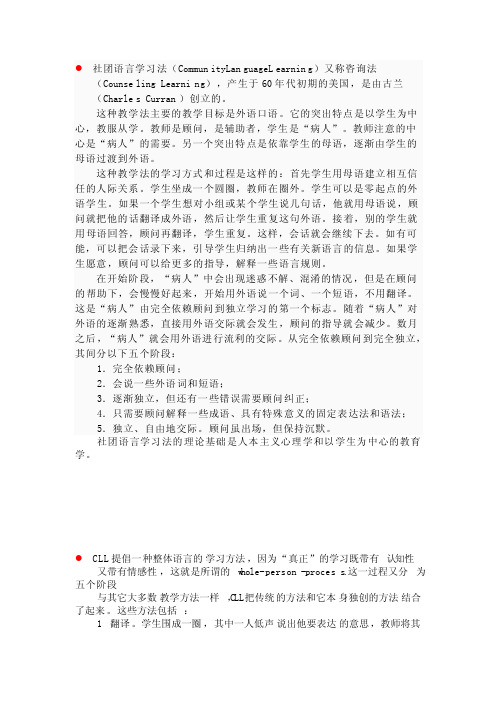
●社团语言学习法(Communi tyLang uageLe arning)又称咨询法(Counsel ing Learnin g),产生于60年代初期的美国,是由古兰(Charles Curran)创立的。
这种教学法主要的教学目标是外语口语。
它的突出特点是以学生为中心,教服从学。
教师是顾问,是辅助者,学生是“病人”。
教师注意的中心是“病人”的需要。
另一个突出特点是依靠学生的母语,逐渐由学生的母语过渡到外语。
这种教学法的学习方式和过程是这样的:首先学生用母语建立相互信任的人际关系。
学生坐成一个圆圈,教师在圈外。
学生可以是零起点的外语学生。
如果一个学生想对小组或某个学生说几句话,他就用母语说,顾问就把他的话翻译成外语,然后让学生重复这句外语。
接着,别的学生就用母语回答,顾问再翻译,学生重复。
这样,会话就会继续下去。
如有可能,可以把会话录下来,引导学生归纳出一些有关新语言的信息。
如果学生愿意,顾问可以给更多的指导,解释一些语言规则。
在开始阶段,“病人”中会出现迷惑不解、混淆的情况,但是在顾问的帮助下,会慢慢好起来,开始用外语说一个词、一个短语,不用翻译。
这是“病人”由完全依赖顾问到独立学习的第一个标志。
随着“病人”对外语的逐渐熟悉,直接用外语交际就会发生,顾问的指导就会减少。
数月之后,“病人”就会用外语进行流利的交际。
从完全依赖顾问到完全独立,其间分以下五个阶段:1.完全依赖顾问;2.会说一些外语词和短语;3.逐渐独立,但还有一些错误需要顾问纠正;4.只需要顾问解释一些成语、具有特殊意义的固定表达法和语法;5.独立、自由地交际。
顾问虽出场,但保持沉默。
社团语言学习法的理论基础是人本主义心理学和以学生为中心的教育学。
●CLL提倡一种整体语言的学习方法,因为“真正”的学习既带有认知性又带有情感性,这就是所谓的w hole-person-process.这一过程又分为五个阶段与其它大多数教学方法一样,C LL把传统的方法和它本身独创的方法结合了起来。
Cooperative Language Learning合作学习语言法

Procedure
This book provides an example of how a collaborative writing lesson would be carried out. A cooperative writing and editing pair arrangement is used.
Premise 4 is that one learns how these cooperative maxims are realized in one’s native language through casual, everyday conversational interaction.
第四页,共19页。
第十六页,共19页。
Conclusion
Advantages Providing opportunities for learners to
develop successful learning and communication skills and to develop friendship with pleasure Enhancing learner motivation and reducing learnerditional models of classroom learning are teacher-fronted, foster competition rather than cooperation, and favor majority students.
CLL has been embraced as a way of promoting communicative interaction in the classroom and is seen as an extension of the principles of Communicative Language Teaching. It is learner-centered.
合作语言学习法PPT课件
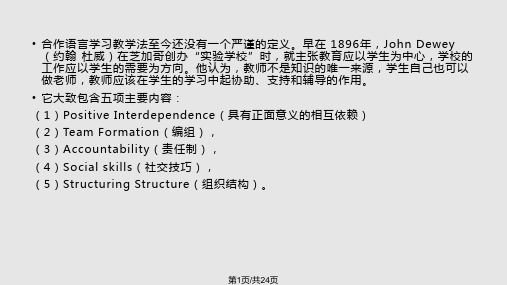
2.合作语言学习教学法在课堂组织结构方面和传统 的课堂比较
传统课堂 有何特点?
第8页/共24页
2.合作语言学习教学法在课堂组织结构方面和传统 的• 在课传堂统课比堂较上,学生集体听课,举手回答问题,集体参加笔头考试。
合作语言学习教学法则重视学生的个体差别,以满足每个学生不同 的需要为目的。下面先就教师教课方式作一个简单的对比。从这个 对比中可以看出来,传统教学要求学生在教室里安静严肃,一般不 允许随意交谈。合作语言学习教学法则创造条件,鼓励学生尽量多 说,大胆开口,不怕讲错。学生在课堂上可以随时提问,问同学、 问老师,随时把不懂的东西弄懂。
• 优点:让学生既学又教就是给他们发展调查和教的技能的机会。如果任务提得好, 学生通过完成任务得到的东西就能成为极好的考试复习资料。
• 不足:有的学生会感到时间紧,在调查结束后没有时间再去教其他小组。在这种情 况下,学生需要增加调查和讨论问题的时间。
第13页/共24页
3.3. 将全班分成两组进行辩论
第3页/共24页
1.合作学习教学的理论依据
• 1.1 建构主义学习理论
•
建习者被动地接受知识,
而是积极的建构知识的过程;学习不单是知识由外向内的转移和传递,更是学习者主动建构自己的知识经
验的过程。学生们在教师的组织和引导下一起讨论和交流,共同建立起学习群体并成为其中一员。
第9页/共24页
第10页/共24页
3.八种合作学习的分组类型
(•
教分种师派是可学由以习教根小师据组根实通据际常 每情有 个况两 学参种 生考做 各使法 方用。 面) 一 不种 同是的
让学生凭兴趣任意选 特点,把程度参差不
择 齐
,一 的学
Community Language Learning

Community Language Learning社团学习法(Community Language Learning, 简称 CLL) , 又称咨询法( Counseling Learning) , 产生于 60年代初期的美国, 是由美国芝加哥 Loyla 大学的心理学教授 Charles A.Curran 提出的一种外语教学法。
社团学习法吸取了心理学中的心理咨询( counseling)的一些理论和实践方法, 把教师看作是教室里的咨询医生( counselor) , 把学生看作是病人( client)。
(刘泽海,2008)其基本程序是: 一群学生在教室里围坐成一个圆圈, 教师站在圈外; 其中一个学生用母语轻声传达一个信息; 教师将此译成外语; 学生用外语重复一遍并用录音机录下; 学生在教师的帮助下用外语传达更多的信息; 学生然后对自己的感觉进行反思。
CLL被称为是人性化的教学技巧(Humanistic Techniques) ,因其增进彼此的信赖,协助学生完成自我接纳, 以自我为荣, 并在外语学习的课堂上培养彼此照应和分享的气氛。
(同上)社团语言学习法是查理斯A. 柯伦( Char lesA. Cu r ran)和他的助手发明的一种语言教学法。
柯伦是美国芝加哥洛佑那(Loyo la)大学的心理学教授, 是咨询教学方面的专家。
社团语言学习正是应用咨询- 学习理论来学习语言的代表方法, 注重统一学生的感情, 思考和了解学生在目标语言中学习些什么, 帮助学生认识他们自己, 接受他们自己, 并为自己感到自豪, 帮助鼓励学生养成一种关心班级、爱护班组的习惯, 形成一种个人和集体相互促进的学习气氛, 老师和同学们一起分享学习外语的乐趣。
社团语言学习法无论在语言理论还是在语言学习理论上,都推崇全人的教育 (whole-person education)。
(陈梅松,2004)柯伦相信, 课堂学习气氛是一个决定性因素。
语言社团学习法The community language learning

❖ Community language learning (CLL) was primarily designed for monolingual conversation classes where the teacher-counselor would be able to speak the learners' L1. The intention was that it would integrate translation so that the students would disassociate language learning with risk taking. It's a method that is based on English for communication and is extremely learner-focused. Although each course is unique and student-dictated, there are certain criteria that should be applied to all CLL classrooms, namely a focus on fluency in the early stages, an undercurrent of accuracy throughout the course and learner empowerment as the main focus.
❖ It's best if you can use a microphone as the sound quality is better and it's easier to pick up and put down.
clil教学法4c框架结构
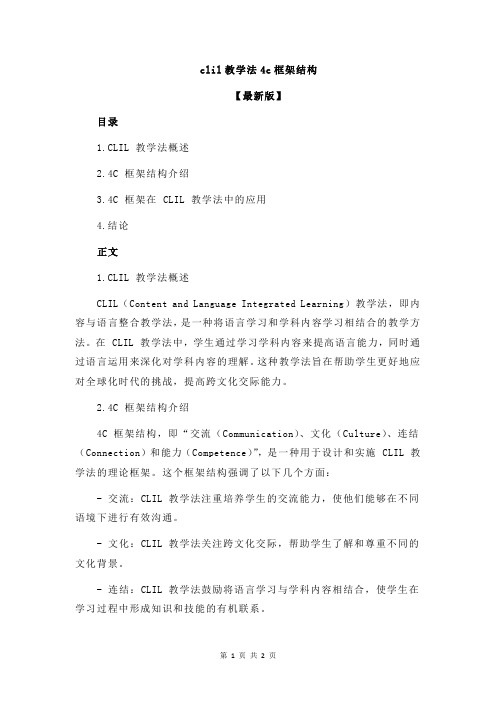
clil教学法4c框架结构【最新版】目录1.CLIL 教学法概述2.4C 框架结构介绍3.4C 框架在 CLIL 教学法中的应用4.结论正文1.CLIL 教学法概述CLIL(Content and Language Integrated Learning)教学法,即内容与语言整合教学法,是一种将语言学习和学科内容学习相结合的教学方法。
在 CLIL 教学法中,学生通过学习学科内容来提高语言能力,同时通过语言运用来深化对学科内容的理解。
这种教学法旨在帮助学生更好地应对全球化时代的挑战,提高跨文化交际能力。
2.4C 框架结构介绍4C 框架结构,即“交流(Communication)、文化(Culture)、连结(Connection)和能力(Competence)”,是一种用于设计和实施 CLIL 教学法的理论框架。
这个框架结构强调了以下几个方面:- 交流:CLIL 教学法注重培养学生的交流能力,使他们能够在不同语境下进行有效沟通。
- 文化:CLIL 教学法关注跨文化交际,帮助学生了解和尊重不同的文化背景。
- 连结:CLIL 教学法鼓励将语言学习与学科内容相结合,使学生在学习过程中形成知识和技能的有机联系。
- 能力:CLIL 教学法旨在提高学生的综合语言运用能力,使他们能够在不同领域和场合中运用语言进行有效沟通。
3.4C 框架在 CLIL 教学法中的应用在 CLIL 教学法中,4C 框架结构为教师提供了一个实用的指导原则,帮助他们更好地设计和实施课程。
教师在教学过程中应关注以下几个方面:- 交流:教师需要为学生创设多样化的交流环境,让他们在不同场景下进行语言实践,提高交流能力。
- 文化:教师应选择具有文化内涵的教学内容,帮助学生了解和理解不同文化背景,培养跨文化意识。
- 连结:教师要善于将语言学习和学科内容相结合,设计富有挑战性的教学活动,引导学生在解决问题的过程中提高语言运用能力。
- 能力:教师应关注学生的个体差异,针对不同学生的需求和特点制定合适的教学策略,提高学生的综合语言运用能力。
cll教学法

cll教学法
CLL教学法是一种基于传统语言教学法的一种升级版教学法。
CLL 是CommunicationLanguageLearning(交际语言教学)的缩写,该教学法注重学生的交际能力培养,鼓励学生通过语言交流来学习语言。
CLL教学法主要通过以下几个方面来实现:
1.教师角色:CLL教学法中,教师不再是传统的“知识传授者”,而是“引导者”和“促进者”。
教师应该创造一个积极、合作、互动的学习环境,鼓励学生自主学习、自我探究。
2.学生角色:CLL教学法中,学生是学习的主体,应该承担更多的责任和义务。
学生应该学会主动提问、交流以及与他人协作,从而提高自己的交际能力。
3.任务型教学:CLL教学法强调任务型教学,即让学生通过完成真实的任务来学习语言。
任务可以是口语、听力、阅读、写作等方面的任务,具有针对性和实用性。
4.语境教学:CLL教学法注重语言的实际应用,通过营造真实的语境来帮助学生掌握语言。
教师可以采用对话、剧本、角色扮演等方式营造语境。
总之,CLL教学法通过创造积极的学习环境、强调任务型教学和语境教学等多个方面来帮助学生提高交际能力,从而实现更好的语言学习效果。
- 1 -。
clil教学法的好处
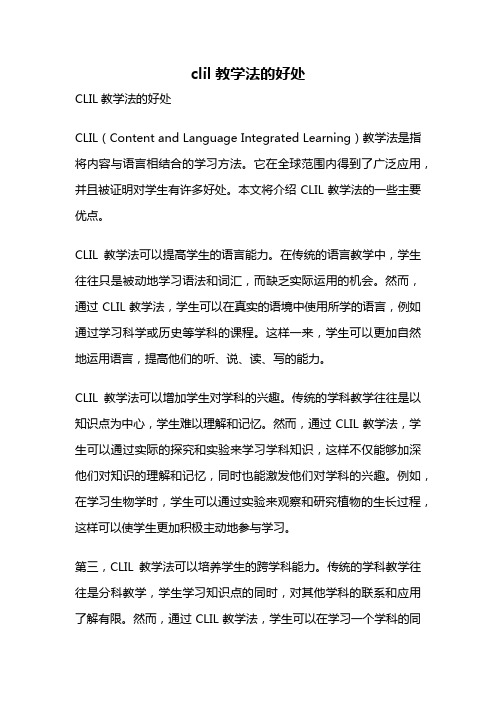
clil教学法的好处CLIL教学法的好处CLIL(Content and Language Integrated Learning)教学法是指将内容与语言相结合的学习方法。
它在全球范围内得到了广泛应用,并且被证明对学生有许多好处。
本文将介绍CLIL教学法的一些主要优点。
CLIL教学法可以提高学生的语言能力。
在传统的语言教学中,学生往往只是被动地学习语法和词汇,而缺乏实际运用的机会。
然而,通过CLIL教学法,学生可以在真实的语境中使用所学的语言,例如通过学习科学或历史等学科的课程。
这样一来,学生可以更加自然地运用语言,提高他们的听、说、读、写的能力。
CLIL教学法可以增加学生对学科的兴趣。
传统的学科教学往往是以知识点为中心,学生难以理解和记忆。
然而,通过CLIL教学法,学生可以通过实际的探究和实验来学习学科知识,这样不仅能够加深他们对知识的理解和记忆,同时也能激发他们对学科的兴趣。
例如,在学习生物学时,学生可以通过实验来观察和研究植物的生长过程,这样可以使学生更加积极主动地参与学习。
第三,CLIL教学法可以培养学生的跨学科能力。
传统的学科教学往往是分科教学,学生学习知识点的同时,对其他学科的联系和应用了解有限。
然而,通过CLIL教学法,学生可以在学习一个学科的同时,了解其他学科的知识和应用。
例如,在学习历史时,学生可以通过阅读文献和研究资料,了解到历史与地理、文学等学科的关系,从而培养他们的跨学科思维能力。
第四,CLIL教学法可以提高学生的学习效果。
传统的学科教学往往只是传授知识点,学生容易忘记和遗忘。
然而,通过CLIL教学法,学生可以将所学的知识与实际生活和实际问题相结合,这样可以提高学生对知识的理解和应用能力。
例如,在学习数学时,学生可以通过解决实际问题来应用所学的数学知识,这样可以使学生更加深入地理解和记忆所学的知识。
CLIL教学法可以培养学生的终身学习能力。
传统的学科教学往往只是传授知识点,学生的学习方式和方法比较单一。
合作语言教学法PPT课件
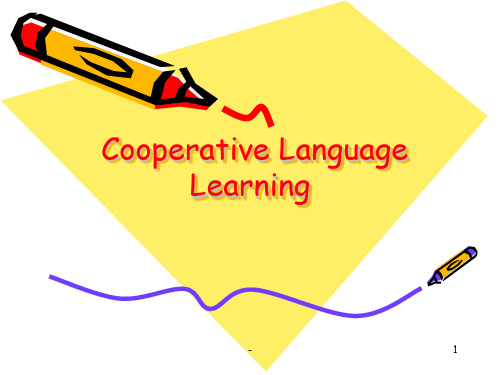
and are used to focus student attention or to facilitate learning during direct teaching. • Cooperative base groups: These are long term, lasting for at least a year and consist of heterogeneous learning groups with stable membership whose primary purpose is to allow members to give each other the support, help, encouragement, and assistance they need to succeed academically.
-
3
Theoretical Background
• Communicative approach
In the ESL classroom, CLL is seen as an extension of Communication Language Teaching that tends to be more learner-centered.
-
8
Cooperative learning Activities
• Three-step interview • Roundtable • Think-Pair-Share • Solve-Pair-Share • Numbered Heads
昂立英语教学方法汇总-COMMUNITYLANGUAGELEARNING团体语言学习法

昂立英语教学方法汇总-COMMUNITYLANGUAGELEARNING团体语言学习法MUNITY LANGUAGE LEARNING (CLL; orCOUNSELING LEARNING)团体语言学习法历史背景与渊源CLL 是由一位谘商专家兼大学心理学教授Charles A. Curran 所创立。
它有三大基础:(1)CLL将谘商中当事者(client)与谘商人员(counselor)的关系运用在教学过程中学生(learner)与教师(knower)的身上;(2)CLL是所谓较〝全人〞式的教学方法(humanistic techniques),因为他不只将L2传授给学生,还会顾及到学生在学习过程中的感觉与情绪;(3)CLL采用〝语码转换〞(code alternation)进行教学---学生先用L1说出所欲学习的标的物,教师将其翻译为L2后,学生再一边将所听到的L2念出来给同学听,一边将它录在录音机中。
教学观在CLL的理论中,语言不只是一套传递讯息的输送系统(Information-transmitting model),而是一套社会过程模式(social-process mode)---说话者〝本身〞和所欲传达的〝讯息〞两者皆会影响和听者间的关系。
Curran 表示,语言就是人和人之间响应与互动的关系。
这种关系又可分为学生与学生之间、学生与老师之间等两层子关系:学生在学习中彼此会发展出熟悉亲近的关系,而学生和老师之间则从依赖一直进展到相互独立的阶段。
这两层人际/ 社会关系皆会影响学习的效果。
至于心理语言学方面,Curran 也提出四点会影响语言学习的因素:能使学习能力提升的安全感(security)、能使学生投入在学习过程中的注意力(attention)、会把握机会练习L2的企图心(aggression)以及促成整合分析的鉴别力(determination)。
综而言之,CLL的教学观不只包含了认知过程与心理语言学发展的观点,更顾及了学习过程开始前就已经深深影响着学习者的个人情绪层面。
论CLIL六步教学法
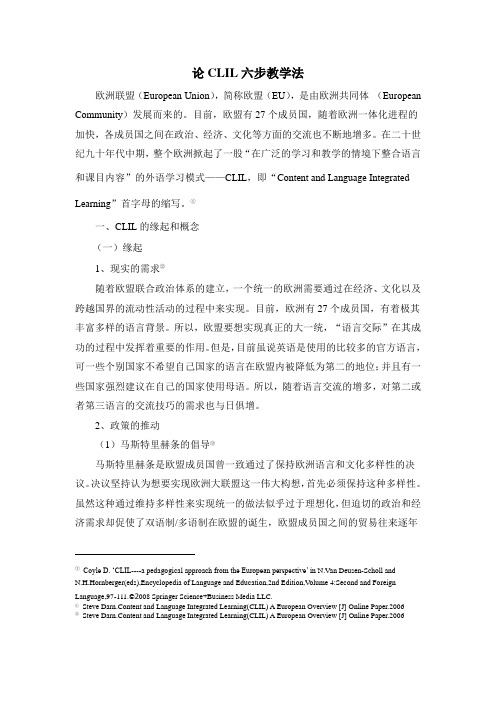
论CLIL六步教学法欧洲联盟(European Union),简称欧盟(EU),是由欧洲共同体(European Community)发展而来的。
目前,欧盟有27个成员国,随着欧洲一体化进程的加快,各成员国之间在政治、经济、文化等方面的交流也不断地增多。
在二十世纪九十年代中期,整个欧洲掀起了一股“在广泛的学习和教学的情境下整合语言和课目内容”的外语学习模式——CLIL,即“Content and Language Integrated Learning”首字母的缩写。
①一、CLIL的缘起和概念(一)缘起1、现实的需求②随着欧盟联合政治体系的建立,一个统一的欧洲需要通过在经济、文化以及跨越国界的流动性活动的过程中来实现。
目前,欧洲有27个成员国,有着极其丰富多样的语言背景。
所以,欧盟要想实现真正的大一统,“语言交际”在其成功的过程中发挥着重要的作用。
但是,目前虽说英语是使用的比较多的官方语言,可一些个别国家不希望自己国家的语言在欧盟内被降低为第二的地位;并且有一些国家强烈建议在自己的国家使用母语。
所以,随着语言交流的增多,对第二或者第三语言的交流技巧的需求也与日俱增。
2、政策的推动(1)马斯特里赫条的倡导③马斯特里赫条是欧盟成员国曾一致通过了保持欧洲语言和文化多样性的决议。
决议坚持认为想要实现欧洲大联盟这一伟大构想,首先必须保持这种多样性。
虽然这种通过维持多样性来实现统一的做法似乎过于理想化,但迫切的政治和经济需求却促使了双语制/多语制在欧盟的诞生,欧盟成员国之间的贸易往来逐年①Coyle D. ‘CLIL----a pedagogical approach from the European perspective’ in N.Van Deusen-Scholl andN.H.Hornberger(eds),Encyclopedia of Language and Education,2nd Edition,V olume 4:Second and Foreign Language,97-111.©2008 Springer Science+Business Media LLC.①Steve Darn.Content and Language Integrated Learning(CLIL) A European Overview [J] Online Paper.2006②Steve Darn.Content and Language Integrated Learning(CLIL) A European Overview [J] Online Paper.2006看涨,欧盟各国居民之间的交流也日渐频繁。
内容与语言整合教学在多语种教育中的应用

内容与语言整合教学在多语种教育中的应用引言多语种教育一直以来都是一个备受关注的话题,随着全球化的发展和人口迁移的增加,学习多种语言的重要性也日益显现。
内容与语言整合教学(Content and Language Integrated Learning,CLIL)作为一种教学方法,已经在多语种教育中得到广泛应用。
本文将探讨内容与语言整合教学在多语种教育中的应用,以及它对学生的语言和认知发展的影响。
内容与语言整合教学是什么内容与语言整合教学(CLIL)是一种综合性的教学方法,其目的是在教授某一学科的同时,也以该学科的语言为媒介进行教学。
它将内容与语言结合起来,使学生在学习某一学科的同时也能够提高他们的语言能力。
CLIL方法强调学科知识和语言能力的融合,通过给学生提供丰富的学科内容,培养他们的思辨能力、综合能力和语言表达能力。
CLIL的优势提高语言能力一个显著的优势是,CLIL可以提高学生的语言能力。
通过使用学科专业的语言进行教学,学生在学习学科知识的同时也在运用目标语言进行交流和表达。
这种语言环境的创造可以促使学生更加主动地学习目标语言,并提高他们的听说读写能力。
CLIL教学能够帮助学生在真实的学科场景中应用语言,增加他们的语言输入和输出。
培养综合能力CLIL教学注重学科内容和语言能力的融合,在学习某一学科的同时培养学生的综合能力。
学生需要通过阅读、听讲座、讨论等方式获取学科知识,并用目标语言进行表达和交流。
CLIL教学提供了一个综合性的学习环境,使学生能够主动参与学科内容的学习,并在实践中提高他们的思维能力、创新能力和解决问题的能力。
增强跨文化意识CLIL教学涉及跨文化交流,学生会接触到不同的语言和文化背景。
通过学习不同的学科内容,学生能够更深入地了解其他文化,并增强他们的跨文化意识。
这对于培养学生的国际视野和跨文化交流能力非常重要,使他们能够适应全球化的发展和国际交流。
CLIL在多语种教育中的应用提高语言学习效果在多语种教育中,学生需要学习多种语言。
- 1、下载文档前请自行甄别文档内容的完整性,平台不提供额外的编辑、内容补充、找答案等附加服务。
- 2、"仅部分预览"的文档,不可在线预览部分如存在完整性等问题,可反馈申请退款(可完整预览的文档不适用该条件!)。
- 3、如文档侵犯您的权益,请联系客服反馈,我们会尽快为您处理(人工客服工作时间:9:00-18:30)。
2 If I swim ,you sink;If you swim,I sink 3 Negative Interdependence
4 Negative Correlation
Advantages of CLL
Johnson brothers
Formal cooperative learning groups Informal cooperative learning groups
Cooperative base groups
Time
Groups
Purpose
to achieve shared learning goals to focus student attention/ facilitate learning
积极互赖 小组构成 个体责任 社交技能 组织结构
● What helps one member helps all and what hurts one member hurts all ● A spirit of mutual support ● Each group member's efforts are required and indispensable for group success
● Team practice from common input
● Jigsaw ● Cooperative projects
Team practice from common input
Same material
Everyone knows/ explains/ understands
Anyone
1 ↑ frequency and variety
2 ↑ cognitive development language skills 3 ↑ language + content--based instruction 4 ↑ language and concept learning
5 ↑ communication
The 1960s and 1970s
The forced integration of public schools
理论基础
1 马斯洛的“需要”理论
Байду номын сангаас
2 “群体动力”理论
Five Goals
1 ↑ naturalistic second language acquisition(S) 2 ↑ a methodology can be applied in a variety of curriculum settings(T) 3 ↑ particular lexical items ,language structure,communicative function
● Both two groups involvement ● Multilevel class ● Information-gap activities
Students with the same piece regroup in expert groups
Share & Synthesize
Information-gap activities are those in which students are given different bits of information. By sharing this separate information they can complete a task.
6 ↑ resources and more active roles
Design
Objectives The Syllabus Types of CL Groups
Conclusions
Key Elements
Activity Types of CLL CLL Activities Roles (Learner, Teacher, Instructional Materials) Procedure
● Three-step Interview (三步谈话) ● Roundtable (圆桌会议) ● Think-Pair-Share (结对思 考) ● Solve-Pair-Share (结对解答) ● Numbered Heads (随机点号)
Three-step interview
Student A: interviewer
Cooperative projects
Group: different topics Member: subtopics
Research the information (subtopics)
Synthesize
Presentation
● Individualization & Students' interests
Cooperative Language Learning
Contents
1 Background 2 Approach 3 Design
4 Conclusions
Cooperative Language Learning
1 make maximum use of cooperative activities(like pairs and groups)
● Review & Practice tests
● Effective in situations where the composition is unstable (adult programs)
Jigsaw (Aronson)
Group: same material Member: different pieces Return to home groups
sink or swim together
tasks
● Size age 2 —4
time limits
teacher-selected √ ● Assignment random student-selected
● Something that every team member must shoulder ● Each member group is accountable for his/her learning and actions as well as the group learning and performance ● An element required to prevent and lower the likelihood of free riders or social loafing
4 ↑successful learning and communicative stategies (S)
5 ↑motivation and stress ↓(S)
Theory of language(5 promises)
Approach
Theory of learning(social interaction)
Overall Objectives of CLL
● To foster cooperation ● To develop critical thinking skills ● To develop communicative competence
Specific Objectives
● Derive from the context in which it is used
If you have an apple and I have an apple and we exchange these apples then you and I will still each have one apple.But if you have an idea and I have an idea and we exchange these ideas ,then each of us will have two ideas.
Theory of language
1 communication
2 conversation
5 promises
3 maxims=rules (准则)
4 interaction
5 participation
Theory of learning
Cooperative Learning
social interaction
● Blackboard Share (共享黑板) ● Round Robin (接力循环) ● Pairs Check (结对检查) ● Team Word-Webbing (小组语词联网) ● Match Mine (照我做) ● Inside/Outside Circles (内圈—外圈) ● Partners (小伙伴) ● Jigsaw (切块拼接) ● STAD (学生小组成绩分工法) ● GI (小组调查法) ● MURDER (组合阅读法)
to give each other the support, help, encouragement, and assistance
one class period— learning groups several weeks
a few minutes—a class period
ad-hoc (special) groups
● The way students interact with each other as teammates
● Leadership, decision-making, trust-building, communication, conflictmanagement skills
